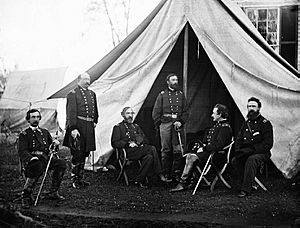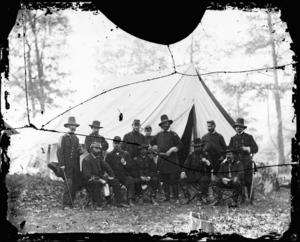Army of the Potomac facts for kids
Quick facts for kids Army of the Potomac |
|
|---|---|

Commanders of the Army of the Potomac at Culpeper, Virginia, 1863. From the left: Gouverneur K. Warren, William H. French, George G. Meade, Henry J. Hunt, Andrew A. Humphreys, George Sykes
|
|
| Active | July 26, 1861–June 28, 1865 |
| Country | |
| Branch | |
| Type | Field army |
| Role | Primary Union Army in Eastern Theater |
| Part of | Union Army |
| Garrison/HQ | Washington, D.C. |
| Engagements | American Civil War |
| Commanders | |
| Notable commanders |
George B. McClellan Ambrose Burnside Joseph Hooker George G. Meade |
The Army of the Potomac was the main army for the Union Army during the American Civil War. It fought from 1861 to 1865 in the eastern part of the United States. People sometimes called it Mr. Lincoln's Army because President Abraham Lincoln was very involved with it.
This army had two important jobs. First, it had to protect Washington, D.C., the capital city. Second, its goal was to defeat the main Confederate army, called the Army of Northern Virginia. Many of the generals who led the Army of the Potomac faced a lot of challenges. Under leaders like Irvin McDowell, George McClellan, Joseph Hooker, and George G. Meade, the army often faced tough battles.
Contents
History of the Army of the Potomac
The Army of the Potomac started after the American Civil War began. President Lincoln asked for 75,000 volunteer soldiers from the Northern states. This call came just a day after the Confederates took over Fort Sumter. These soldiers were meant to serve for 90 days.
In 1861, the regular U.S. Army was quite small. Most of its soldiers were spread out on duty in the western parts of the country. There was a big need to quickly gather a strong army. Washington, D.C., felt threatened because about 20,000 Confederate troops were camped only 25 miles away.
During the spring and early summer of 1861, many volunteers joined the army. New groups of soldiers arrived almost every day. They even camped on the White House lawn! On May 24, 1861, Brigadier general Irwin McDowell took command of this new army. It was first called the Army of Northeastern Virginia.
Even though the soldiers were still training, McDowell was ordered to fight the Confederate forces near Manassas, Virginia. He moved his army slowly, which gave the Confederate commander, P. G. T. Beauregard, time. Beauregard called for more soldiers from another general, Joseph E. Johnston. The big fight that followed was known as the First Battle of Bull Run.
The First Battle of Bull Run
The First Battle of Bull Run, also called the First Battle of Manassas, happened on July 21, 1861. It was the first major battle of the American Civil War. General McDowell tried to march part of his army around the left side of the Confederate army. This was a plan to attack them from the side.
The fighting began around 6 a.m. near Matthews Hill. The Confederates were surprised by the attack. But they quickly moved their troops to defend their left side. The Union army pushed the Confederates back from Matthews Hill by about 11 a.m. The Confederates then fell back to another hill called Henry House Hill.
On Henry House Hill was Thomas J. Jackson's brigade. Another Confederate general was trying to get his men back in order. When Jackson bravely moved his brigade forward to fill a gap in the Confederate line, the general shouted, "Look men, there is Jackson standing like a stone wall!" After this battle, Thomas Jackson became famous as "Stonewall Jackson."
All the Union attacks on the Confederate lines failed. In the afternoon, the Confederates launched their own attack. This pushed the Union army all the way back towards Washington, D.C. The Confederates were too tired to chase them further.
Just four days later, General McDowell was replaced. Major general George B. McClellan took command. A month later, the army's name was officially changed to the Army of the Potomac. McClellan focused on training the new soldiers. He organized the army well and made sure they had good equipment.
For several months, President Lincoln kept urging McClellan to attack the Confederate army. Finally, Lincoln demanded that McClellan take action.
The Peninsula Campaign
In March 1862, the Army of the Potomac began its first big attack. This was called the Peninsula Campaign. General McClellan landed his army at Fort Monroe in Virginia. From there, the army moved northwest, heading up the Virginia Peninsula.
McClellan was surprised by the strong Confederate defenses along the Warwick Line. He decided to prepare for a siege of Yorktown, Virginia. But before the Union army was ready, the Confederates started to retreat towards Richmond, the Confederate capital.
The first heavy fighting of this campaign happened in the Battle of Williamsburg. Union troops won some small victories, but the Confederates kept retreating. An attempt by the U.S. Navy to reach Richmond by the James River failed in the Battle of Drewry's Bluff.
Images for kids
-
Grand Review of the Army of the Potomac, drawn by Thomas Nast, Harper's Weekly, October 10, 1863
-
Saint Patrick's Day celebration in the Army of the Potomac, depicting a steeplechase race among the Irish Brigade, March 17, 1863, by Edwin Forbes
-
Scouts and guides, Army of the Potomac, Mathew Brady
-
Headquarters of the 5th Corps, Army of the Potomac, at the home of Col. Avery near Petersburg, Virginia, June 1864. Photograph by Mathew Brady. From the Liljenquist Family Collection of Civil War Photographs, Prints and Photographs Division, Library of Congress
See also
 In Spanish: Ejército del Potomac para niños
In Spanish: Ejército del Potomac para niños






